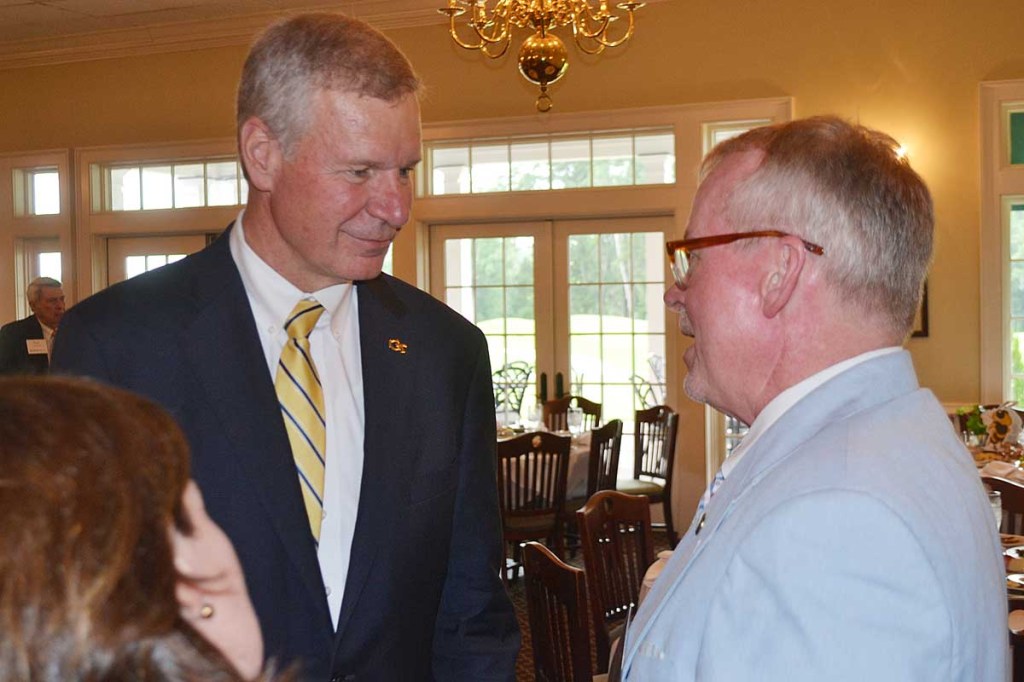Tech president shows school’s reach into south Georgia
Published 1:59 pm Saturday, June 24, 2017

- Robby Pitts, right, speaks with Georgia Tech President Dr. G.P. "Bud" Peterson after the Dr. Peterson's talk with local alumni Wednesday at Glen Arven Country Club.
THOMASVILLE —That Georgia Tech’s reach and impact isn’t just metro Atlanta and that it’s just as local as it is global was part of Dr. G.P. “Bud” Peterson’s message across the southern part of the state.
Peterson, the Georgia Tech president, toured southern Georgia for four days, hitting 12 cities in 44 counties in an itinerary that included a stop in Thomasville on Wednesday. He pointed out the school’s role in economic development, even in the far southern reaches of the state.
“We’ve got 27 sites around the state where we have people who are Georgia Tech employees who try to help connect the business and industries with the talents and technologies that exist at Georgia Tech,” he said.
For instance, Georgia Tech is talking with Nature Nate’s in Valdosta about its honey production facilities processes. The company uses batch processing and has to change its lines, and Peterson said Tech can help them do that more efficiently.
Its experts also have helped a company that sets up ice-making buildings that had problems when water lines froze. With Georgia Tech’s assistance, the company put in wireless connectivity that triggered a heat tape on the water line that would keep the water flowing and allow the ice to be made.
“They saved huge amounts of money doing that,” Peterson said.
According to the school, Tech’s Manufacturing Extension Partnership Program helped 24 South Georgia manufacturers last year, reducing costs by more than $1 million and creating or saving 82 jobs. Tech also leads the Lean Manufacturing Consortium, which enables companies to note best practices and share their solutions and ideas.
Georgia Tech has 93 alumni in Thomas County, and there are 21 students from Thomas County currently enrolled at the school. The Wall Street Journal has ranked Georgia Tech as the No. 1 public university in the South for graduate salaries and U.S. News and World Report has named it the No. 7 public university in the nation.
With nearly 27,000 students in undergraduate and graduate programs, the bulk of Tech’s student population calls Georgia home.
“We are a state institution. We recognize that,” Dr. Peterson said. “We were established to move Georgia from an agrarian economy to an industrial economy. We try to keep sight of that mission. A big part of that mission is educating Georgia students.”
Tech’s goal is to have no fewer than 60 percent of its more than 15,000 undergrads come from in-state. Its slots for international students are capped at 10 percent.
“We do a lot of outreach to make sure that students from all across the state can and do attend Georgia Tech,” Peterson said.
There were approximately 31,400 applicants for this year’s freshman class, and the school took 2,800, an acceptance rate of 23 percent. The school took 45 percent of the applicants from Georgia, and including transfers, Georgia Tech takes more than 50 percent of the annual in-state applicants.
Georgia Tech also boasts of being the only public school in Georgia offering a debt-free degree to qualifying students from low-income families. Through the Wayne Clough Georgia Tech Promise Program, more than 800 students have attended Tech since 2009.
Georgia Tech’s motto of “creating the next” as means it has adapted the programs it offers and how it offers. Once rated as the No. 1 textile engineering school in the nation, Tech combined it with other programs for a materials science school.
“One of the things I did when I got to Tech was to merge the polymer and fiber engineering program department with the materials engineering school,” said Peterson, the school president since 2009. “It’s hard to have a really outstanding materials science program without polymers.”
Tech is moving into cybersecurity and last November received a $15.3 million grant from the Department of Defense.
“The demand for expertise and people with skill sets in the textile industry had diminished. And the demand for people for expertise in cybersecurity is huge,” Peterson said. “That is just one example as the needs of society change, what we’re doing changes. We’re going to try to evolve and stay ahead of the developing technologies.”
The school is involved and engaged with the U.S. Army Cyber Command, headquartered at Fort Gordon in Augusta, Peterson said. Georgia Tech also has developed a library of malware for research purposes, akin to strains of diseases kept the Centers for Disease Control.
“If you’ve got a company and you’ve been (cyber) attacked, we have folks who will come in and help you figure out how to resolve that attack,” Peterson said.
Tech also has started offering courses and programs through MOOC, or massive open online courses. Using the MOOC format, Georgia Tech is offering a computer science degree.
As a result, nearly half of the master’s degrees awarded in computer science at Tech are to students who never set foot on campus. Tech will graduate more than 8 percent of the nation’s master’s degrees in computer science this year.
“This fall there will be more than 5,000 students enrolled, and none of them are on campus,” Peterson said.
Georgia Tech will start a similar program this fall for data analytics and will launch one for cybersecurity in the future, Peterson said.
Peterson’s stop in Thomasville drew nearly 80 people, including alumni from Tallahassee, Florida, to hear him talk all things Georgia Tech. Even the school’s automotive legend, the Ramblin’ Wreck, made an appearance.
The Tech alumni and supporters who turned out for the tour left an impact on Peterson and the staff, he acknowledged.
“We go back and we are really fired up,” he said.



